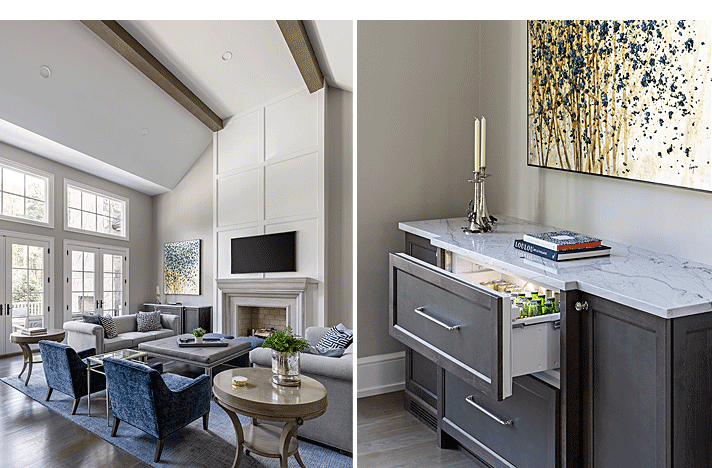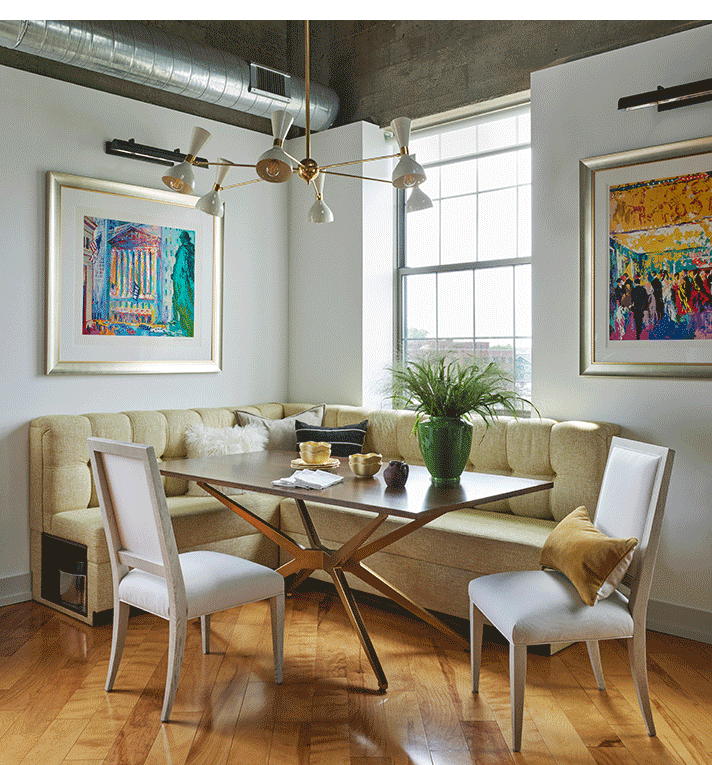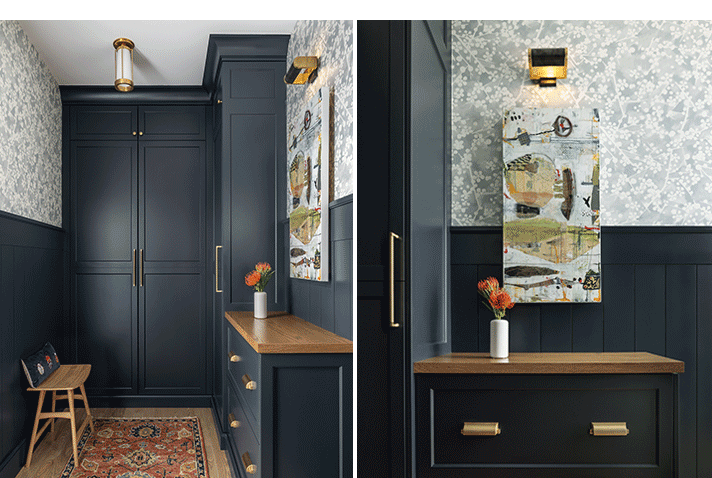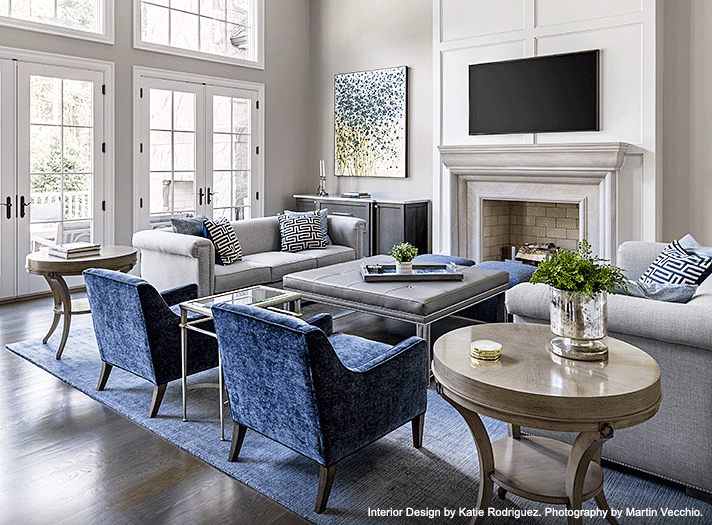Sometimes, the most mundane detail in a space can be where the magic lies. We asked four clever designers how they create interesting solutions for life’s little necessities.

Photograph by George Dzahristos
MAXIMUM STORAGE
“This space used to function as an ordinary closet with bi-fold doors near the back entry of this Birmingham home. It was also very underutilized. The basic challenge was to maximize storage while also making things easily accessible. Although the space was not very wide, it was on the deeper side, which allowed us to create a lot of storage in a small area. For example, sliding doors were installed as opposed to traditional hinged doors to conserve space. This permits entry into the area without sacrificing valuable floor space in the entryway. Built-in cubbies located behind hidden doors provide a designated spot to store footwear—keeping everything contained and preventing a mess on the floor. It’s also a great solution for infrequently used shoes or extra pairs of boots. Finally, the upper shelving is a perfect spot to stash bulkier pantry items, which helps to keep kitchen cabinets organized. The new closet fulfilled the client’s request to design a purposeful and organized area that incorporates the needs of their entire family.” — Jane Synnestvedt, Jane Synnestvedt Interior Design
JANE’S DESIGN TIPS:
- Transform with Texture and Tile: Ordinary features like light switches or built-in cabinets can be elevated with a touch of texture or pattern. Consider replacing plain switch plates with ones made of wood, metal, or ceramic for a unique look. For built-in cabinets, swap out standard doors for something with textured glass, woven panels, or a fun wallpaper inlay.
- Forge Hidden Functionality: Create a built-in bench with storage underneath for shoes or blankets. A simple light fixture can be made special by adding a dimmer switch or motion sensor to turn it on automatically.
- Light Up the Ordinary: Lighting can completely change the feel of a space. It can highlight architectural details, artwork near doorways, or windows with strategically placed sconces. Add a strip light underneath cabinets for a warm glow. Even a simple pendant lamp over a sink can add a touch of personality.
Available at MDC: Resource Center Sherwin Williams paint.

Photography by Martin Vecchio
SEAMLESS INTEGRATION
“The living room of this Bloomfield Hills home opens into a dining room and kitchen, and abuts a beautiful outdoor patio area, so our design intent was to create a bright, open space for family entertainment. The challenge was to design a beverage refrigeration/ wine storage feature that was close to the patio and would seamlessly integrate into the living room. The solution was to construct a piece of furniture that hides all the basic and necessary storage, but is totally functional.” — Katie Rodriguez, Katie Rodriguez Design
KATIE’S DESIGN TIPS:
- Function First: Figure out how you want your space to operate, and then solve how to integrate the function into the space. You can start by making a list of priorities and sketching out a floor plan.
- Get Creative with Cabinetry: Custom furniture has the capacity to be something unique, beautiful, and functional. This works great for beverage stations and drop zones.
- Accessorize: Utilize accessories like a beautiful box to organize and store smaller everyday items, or a leather tray for your daily mail.
Available at MDC: CAI Designs furniture, Lighting Resource Studio art, Resource Center Benjamin Moore paint.

Photograph by Werner Straube
KITTY COMPARTMENT
“This pied-à-terre loft space in Ann Arbor served as a temporary base while my clients renovated their primary residence on Cavanaugh Lake in Chelsea. The homeowners were looking for a comfortable banquette space for dining, working, and relaxing. This was the only dining area in the loft, so they spent a lot of time here eating meals, drinking coffee in the morning, or working on their computers.
I collaborated with Designer Furniture Services + Fabrics to build a banquette with storage beneath, as well as a nook at the end to store their kitty dishes. It’s a simple open niche finished to match the base of the banquette. It’s a neat and simple hideaway for the cat dishes so they weren’t exposed to the open loft space.” — Laura Zender, Laura Zender Design
LAURA’S DESIGN TIPS
- Embrace the Everyday: Spaces should be comfortable and enjoyed by the families that live in them. Sometimes, real life calls for mundane items, so we just embrace them rather than try to pretend that they aren’t there.
- Lean into Lived-In Spaces: The imperfect is far more interesting.

Photography by Martin Vecchio
BEHIND CLOSED DOORS
“For this project, I worked with Elle Tor and Lakes Development Group to redesign the mudroom in this Birmingham home. It was converted from a series of open shelving units into concealed cabinetry. The tall cabinets take the place of a coat closet, while a lower set of drawers just inside the back door are the perfect place to tuck phones, purses, chargers, pet essentials, and all sorts of miscellaneous items. “ — Marianne Jones, Marianne Jones
MARIANNE’S DESIGN TIPS:
- Space Planning: Assess the available space and determine the dimensions for your closed mudroom. Consider the depth, width, and height requirements based on your storage needs and the layout of the room. Do you want a place for a charging station, purses, pet food, or backpacks?
- Storage Solutions: Decide on the types of storage you need, such as shelves, cabinets, hooks, or cubbies. Plan enough room to accommodate coats, shoes, bags, and other items typically found in a mudroom. Customized storage solutions can maximize the use of available space.
- Lighting: Adequate illumination is essential for functionality. Install overhead lighting as well as task lighting near key areas such as storage units or seating areas. A well-placed sconce or picture light can add ambience and detail.
- Design: Consider aesthetic as well as functionality. For example, add playful wallpaper for personality.
